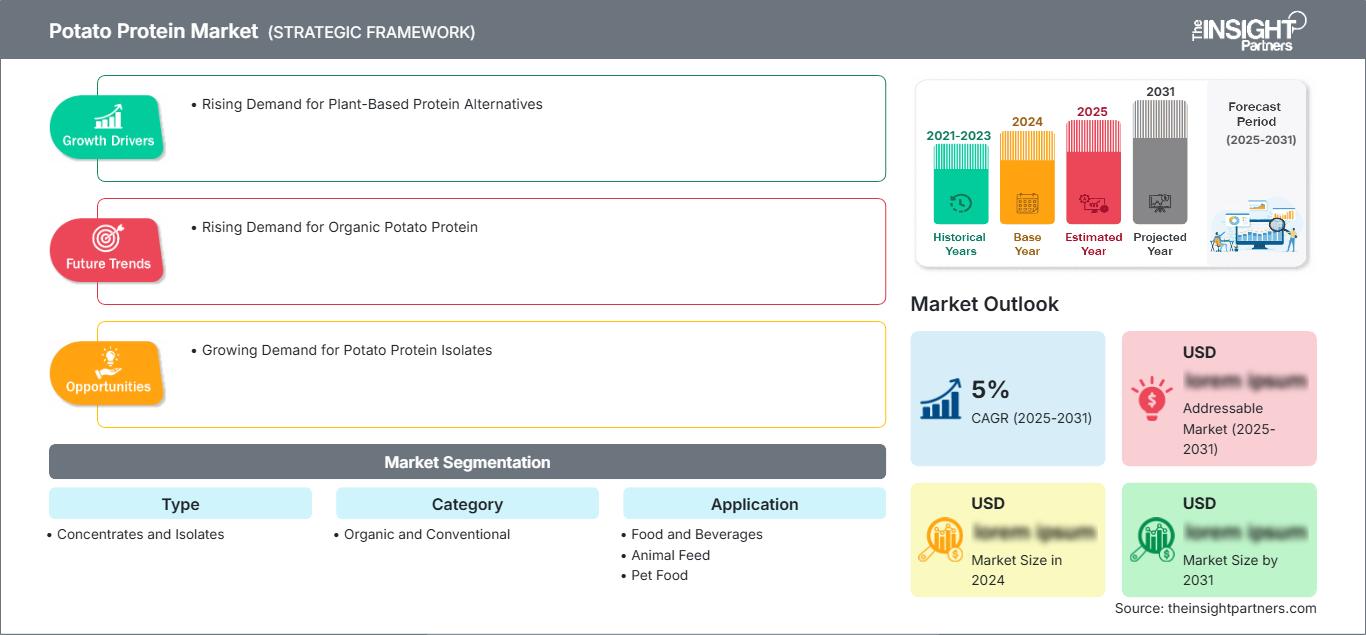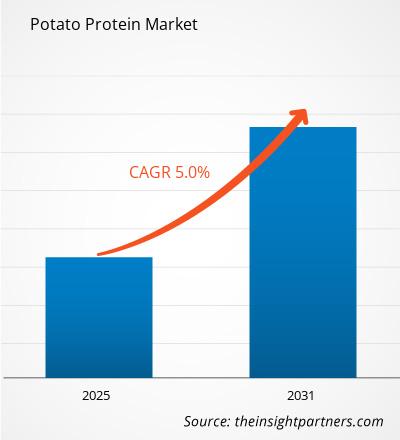Der Markt für Kartoffelprotein wird zwischen 2023 und 2031 voraussichtlich eine durchschnittliche jährliche Wachstumsrate (CAGR) von 5 % verzeichnen. Die steigende Nachfrage nach Bio-Kartoffelprotein wird voraussichtlich ein wichtiger Markttrend bleiben.
Marktanalyse für Kartoffelprotein
- Kartoffelprotein erfreut sich aufgrund der zunehmenden Neigung zu einer pflanzlichen Ernährung zunehmender Beliebtheit. Dies ist der Hauptantrieb für das Wachstum des Marktes für Kartoffelprotein.
- Immer mehr Menschen weltweit ernähren sich vegan. Dies treibt die Nachfrage nach pflanzlichen Proteinprodukten wie Kartoffelproteinen an.
- Darüber hinaus treiben die hervorragende Nährwertqualität und die vielseitigen Eigenschaften von Kartoffelprotein sein Marktwachstum voran.
Marktübersicht für Kartoffelprotein
- Kartoffelprotein bezeichnet das aus Kartoffeln gewonnene Protein. Das Hauptprotein in Kartoffeln heißt Patatin.
- Kartoffelprotein bietet verschiedene Vorteile, wie z. B. einen hohen Nährwert, Vorteile für die Darmgesundheit und vieles mehr.
- Im Vergleich zu anderen pflanzlichen Proteinen hat Kartoffelprotein einen höheren Nährwert und ein Aminosäureprofil.
- Kartoffeln enthalten resistente Stärke, die als Präbiotikum wirkt und so die nützlichen Bakterien im Darm ernährt und die Dickdarmgesundheit fördert.
Passen Sie diesen Bericht Ihren Anforderungen an
Sie erhalten kostenlos Anpassungen an jedem Bericht, einschließlich Teilen dieses Berichts oder einer Analyse auf Länderebene, eines Excel-Datenpakets sowie tolle Angebote und Rabatte für Start-ups und Universitäten.
Kartoffelproteinmarkt: Strategische Einblicke

- Holen Sie sich die wichtigsten Markttrends aus diesem Bericht.Dieses KOSTENLOSE Beispiel umfasst Datenanalysen, die von Markttrends bis hin zu Schätzungen und Prognosen reichen.
Markttreiber und -chancen für Kartoffelprotein Steigende Nachfrage nach pflanzlichen Proteinalternativen
Sie erhalten kostenlos Anpassungen an jedem Bericht, einschließlich Teilen dieses Berichts oder einer Analyse auf Länderebene, eines Excel-Datenpakets sowie tolle Angebote und Rabatte für Start-ups und Universitäten.
Kartoffelproteinmarkt: Strategische Einblicke

- Holen Sie sich die wichtigsten Markttrends aus diesem Bericht.Dieses KOSTENLOSE Beispiel umfasst Datenanalysen, die von Markttrends bis hin zu Schätzungen und Prognosen reichen.
- In den letzten Jahren wurde zunehmend Wert auf Nachhaltigkeit und Ressourcenschonung gelegt.
- Faktoren wie die wachsende Nachfrage nach milchfreien Proteinpräparaten und gesunden Snacks sowie die zunehmende Beliebtheit pflanzlicher Ernährung treiben die Nachfrage nach Kartoffelproteinen an.
- Auch die Fortschritte bei Extraktions- und Verarbeitungstechnologien fördern das Wachstum des Kartoffelproteinmarktes.
Wachsende Nachfrage nach Kartoffelproteinisolaten
- Die wachsende Nachfrage nach Kartoffelproteinisolaten dürfte in den kommenden Jahren weitere lukrative Möglichkeiten für Marktwachstum bieten.
- Die Nachfrage nach Kartoffelproteinisolat wird durch seinen hohen Proteingehalt, seinen neutralen Geschmack und seine Kompatibilität mit veganen Lebensmitteln getrieben. Dies hat es zu einer beliebten Zutat in verschiedenen Lebensmitteln und Getränken gemacht.
- Darüber hinaus steigt die Nachfrage nach Kartoffelproteinisolat in Nährstoffriegeln, Nahrungsergänzungsmitteln und anderen Anwendungen.
- Sie werden zunehmend in Sporternährungsprodukten wie Proteinriegeln, Shakes und Nahrungsergänzungsmitteln verwendet. Die steigende Nachfrage nach Sporternährungsprodukten treibt die Nachfrage nach Kartoffelproteinisolaten an.
Segmentierungsanalyse des Kartoffelproteinmarktberichts
Schlüsselsegmente, die zur Ableitung der Kartoffelproteinmarktanalyse beigetragen haben, sind Typ, Kategorie und Anwendung.
- Basierend auf dem Typ ist der Kartoffelproteinmarkt in Konzentrate und Isolate unterteilt.
- Auf der Grundlage der Kategorie ist der Markt in biologisch und konventionell segmentiert.
- Auf der Grundlage der Anwendung ist der Markt in Lebensmittel und Getränke, Tierfutter und Heimtiernahrung segmentiert. Das Segment Lebensmittel und Getränke ist weiter unterteilt in Back- und Süßwaren, Getränke, Fleischersatz, Milchalternativen und Sonstiges.
Marktanteilsanalyse für Kartoffelprotein nach Regionen
- Der Bericht zum Kartoffelproteinmarkt umfasst eine detaillierte Analyse von fünf großen geografischen Regionen, einschließlich der aktuellen und historischen Marktgröße sowie Prognosen für 2021 bis 2031 für Nordamerika, Europa, den asiatisch-pazifischen Raum (APAC), den Nahen Osten und Afrika (MEA) sowie Süd- und Mittelamerika.
- Jede Region ist weiter in die jeweiligen Länder unterteilt. Dieser Bericht bietet Analysen und Prognosen für mehr als 18 Länder und deckt die Marktdynamik von Kartoffelprotein ab, wie z. B. Treiber, Trends und Chancen, die die Märkte auf regionaler Ebene beeinflussen.
- Darüber hinaus umfasst der Bericht die Fünf-Kräfte-Analyse nach Porter, die die Untersuchung der wichtigsten Faktoren umfasst, die den Kartoffelproteinmarkt in diesen Regionen beeinflussen.
Kartoffelproteinmarkt
Die Analysten von The Insight Partners haben die regionalen Trends und Faktoren, die den Kartoffelproteinmarkt im Prognosezeitraum beeinflussen, ausführlich erläutert. In diesem Abschnitt werden auch die Marktsegmente und die geografische Lage in Nordamerika, Europa, dem asiatisch-pazifischen Raum, dem Nahen Osten und Afrika sowie Süd- und Mittelamerika erörtert.Umfang des Kartoffelprotein-Marktberichts
| Berichtsattribut | Einzelheiten |
|---|---|
| Marktgröße in 2024 | US$ XX million |
| Marktgröße nach 2031 | US$ XX Million |
| Globale CAGR (2025 - 2031) | 5% |
| Historische Daten | 2021-2023 |
| Prognosezeitraum | 2025-2031 |
| Abgedeckte Segmente |
By Typ
|
| Abgedeckte Regionen und Länder | Nordamerika
|
| Marktführer und wichtige Unternehmensprofile |
|
Dichte der Marktteilnehmer für Kartoffelproteine: Verständnis ihrer Auswirkungen auf die Geschäftsdynamik
Der Markt für Kartoffelprotein wächst rasant, angetrieben von der steigenden Nachfrage der Endverbraucher aufgrund von Faktoren wie sich verändernden Verbraucherpräferenzen, technologischem Fortschritt und einem stärkeren Bewusstsein für die Produktvorteile. Mit steigender Nachfrage erweitern Unternehmen ihr Angebot, entwickeln Innovationen, um den Bedürfnissen der Verbraucher gerecht zu werden, und nutzen neue Trends, was das Marktwachstum weiter ankurbelt.

- Holen Sie sich die Kartoffelproteinmarkt Übersicht der wichtigsten Akteure
Der Kartoffelproteinmarkt wird durch die Erhebung qualitativer und quantitativer Daten aus Primär- und Sekundärforschung bewertet, die wichtige Unternehmenspublikationen, Verbandsdaten und Datenbanken umfasst. Einige der Entwicklungen auf dem Kartoffelproteinmarkt sind nachfolgend aufgeführt:
- Royal Avebe, die bahnbrechende landwirtschaftliche Genossenschaft, die für ihre innovativen Zutaten auf Kartoffelbasis bekannt ist, gibt stolz die Einführung von PerfectaSOL® bekannt, der nächsten Generation von Kartoffelproteinprodukten. (AVEBE/Unternehmenswebsite/Neuigkeiten/November 2023)
- Awevo Foods, ein spanisches Startup für pflanzliche Eier mit Sitz in Madrid, hat sein erstes Produkt für die Gastronomie und den Einzelhandel auf den Markt gebracht. Die pflanzlichen Eier von Awevo sollen nicht von herkömmlichen Eiern zu unterscheiden sein und denselben Geschmack, dieselbe Textur und dasselbe Aussehen wie ihre tierischen Gegenstücke aufweisen. Sie werden hauptsächlich aus Kartoffelprotein hergestellt und enthalten weder Cholesterin noch gesättigte Fette. (Potato News Today /Unternehmenswebsite/News/Juni 2024)
Bericht zum Kartoffelproteinmarkt: Abdeckung und Ergebnisse
Der „Marktgröße und -prognose für Kartoffelprotein (2021–2031)“ Der Bericht bietet eine detaillierte Analyse des Marktes und deckt die folgenden Bereiche ab:
- Marktgröße und Prognose für Kartoffelprotein auf globaler, regionaler und Länderebene für alle abgedeckten wichtigen Marktsegmente
- Markttrends für Kartoffelprotein sowie Marktdynamik wie Treiber, Einschränkungen und wichtige Chancen
- Detaillierte Porter's Five Forces- und SWOT-Analyse
- Marktanalyse für Kartoffelprotein mit wichtigen Markttrends, globalen und regionalen Rahmenbedingungen, wichtigen Akteuren, Vorschriften und aktuellen Marktentwicklungen
- Branchenlandschaft und Wettbewerbsanalyse mit Marktkonzentration, Heatmap-Analyse, prominenten Akteuren und aktuellen Entwicklungen auf dem Kartoffelproteinmarkt
- Detaillierte Unternehmensprofile
- Historische Analyse (2 Jahre), Basisjahr, Prognose (7 Jahre) mit CAGR
- PEST- und SWOT-Analyse
- Marktgröße Wert/Volumen – Global, Regional, Land
- Branchen- und Wettbewerbslandschaft
- Excel-Datensatz
Aktuelle Berichte
Erfahrungsberichte
Grund zum Kauf
- Fundierte Entscheidungsfindung
- Marktdynamik verstehen
- Wettbewerbsanalyse
- Kundeneinblicke
- Marktprognosen
- Risikominimierung
- Strategische Planung
- Investitionsbegründung
- Identifizierung neuer Märkte
- Verbesserung von Marketingstrategien
- Steigerung der Betriebseffizienz
- Anpassung an regulatorische Trends




















 Kostenlose Probe anfordern für - Kartoffelproteinmarkt
Kostenlose Probe anfordern für - Kartoffelproteinmarkt